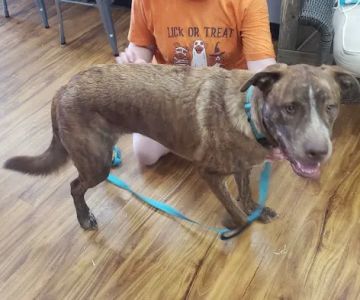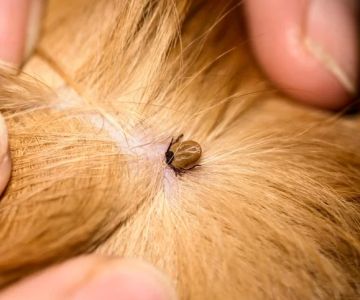1. Signs Your Dog Might Have Food Allergies
- What Are Food Allergies in Dogs?
- Common Signs of Food Allergies in Dogs
- How to Identify Food Allergy Symptoms in Your Dog
- Treatment Options for Food Allergies in Dogs
- Real-Life Case Studies: Managing Food Allergies in Dogs
- How Hidden Brook Veterinary Can Help with Food Allergies
1.1 What Are Food Allergies in Dogs?
Food allergies in dogs occur when their immune system reacts negatively to a specific ingredient in their food. Unlike food intolerances, which are digestive issues, food allergies involve the immune system and can lead to a range of symptoms, from mild to severe. Common allergens include proteins like beef, chicken, dairy, or grains like wheat and corn.
Recognizing food allergies in dogs can be challenging because the symptoms often overlap with other health issues. However, once identified, food allergies can be managed with changes to your dog’s diet and proper veterinary care. In this article, we’ll explore the signs of food allergies in dogs, how to identify them, and the treatment options available to help your pet live comfortably.
2. Common Signs of Food Allergies in Dogs
If your dog is suffering from food allergies, you may notice a variety of signs. Some of these symptoms can also indicate other health issues, so it’s important to consult with a veterinarian for a proper diagnosis. Below are some of the most common signs that your dog may have food allergies:
2.1 Itchy Skin and Excessive Scratching
One of the most common signs of food allergies in dogs is itching. Dogs may scratch, bite, or lick their skin excessively, especially around their face, paws, ears, or belly. This occurs because allergens in their food trigger an immune response, which leads to skin irritation and inflammation. If you notice that your dog’s skin seems irritated, inflamed, or covered in sores, it could be a sign of an allergy.
2.2 Digestive Issues
Food allergies in dogs can also lead to digestive issues, such as vomiting, diarrhea, or gas. If your dog experiences frequent gastrointestinal distress after eating, it could be a sign that their food is causing an allergic reaction. These symptoms can also be associated with food intolerances or infections, so it’s important to rule out other causes with your veterinarian.
2.3 Ear Infections
Recurring ear infections are another common symptom of food allergies. Allergies can cause inflammation in your dog’s ears, leading to infections that may produce foul odors, excessive wax, or scratching at the ears. If your dog frequently develops ear infections that are difficult to treat, food allergies could be a contributing factor.
2.4 Hair Loss and Bald Patches
In some cases, food allergies in dogs can lead to hair loss, particularly in areas where your dog is scratching or licking excessively. This hair loss is typically caused by inflammation and irritation of the skin, which can damage hair follicles. Bald patches may appear around your dog’s legs, ears, or underbelly, where they tend to lick or scratch the most.
2.5 Swelling or Hives
Swelling or the appearance of hives (raised, red bumps) on your dog’s skin can also be signs of an allergic reaction. These symptoms can appear suddenly and may be accompanied by other signs such as itching or discomfort. Swelling around the face, ears, or eyes is particularly concerning and should be addressed immediately by a veterinarian.
3. How to Identify Food Allergy Symptoms in Your Dog
Identifying food allergies in dogs often requires a process of elimination. If you suspect your dog has a food allergy, the first step is to observe their symptoms and consult with your veterinarian. Your vet will likely recommend an elimination diet to help identify the specific allergen causing the symptoms. Here’s how the process works:
3.1 Elimination Diet
An elimination diet involves feeding your dog a novel protein source (such as lamb or duck) and carbohydrate (such as sweet potato) for 8-12 weeks. During this time, you must avoid giving your dog any other treats or food that could contain potential allergens. If your dog’s symptoms improve during the elimination diet, your vet will gradually reintroduce other ingredients to pinpoint the specific allergen.
3.2 Allergy Testing
In some cases, your veterinarian may recommend allergy testing, either through blood tests or intradermal skin tests. These tests can help identify specific allergens that your dog is sensitive to, but they are not always definitive for food allergies. Allergy testing is generally more accurate for environmental allergens than for food-related issues.
3.3 Veterinary Consultation
If you suspect your dog has a food allergy, it’s important to consult with a veterinarian before making any drastic changes to their diet. A professional will be able to guide you through the diagnostic process and recommend the best course of action for your dog’s health.
4. Treatment Options for Food Allergies in Dogs
Once a food allergy has been diagnosed, there are several treatment options available to help manage your dog’s condition and alleviate their symptoms:
4.1 Dietary Changes
The primary treatment for food allergies in dogs is a change in diet. Your veterinarian will help you choose a food that avoids the allergens causing the reaction. This may involve switching to a hypoallergenic dog food or a diet that contains novel proteins and carbohydrates that your dog has not been exposed to before.
4.2 Medications
In cases where the symptoms are severe or persistent, your veterinarian may prescribe medications to help alleviate the symptoms of food allergies. These may include antihistamines, steroids, or anti-inflammatory medications to reduce itching, swelling, and discomfort. Medications can be used in combination with dietary changes to help provide relief.
4.3 Ongoing Monitoring and Adjustments
Managing food allergies in dogs is an ongoing process that requires regular veterinary checkups and monitoring. Your dog’s needs may change over time, and adjustments to their diet or treatment plan may be necessary. Regular follow-ups with your veterinarian will help ensure that your dog remains comfortable and healthy.
5. Real-Life Case Studies: Managing Food Allergies in Dogs
Let’s take a look at a couple of real-life cases where dogs have successfully managed their food allergies with the right approach:
5.1 Max’s Story
Max, a 4-year-old Labrador, had been suffering from persistent itching and ear infections for months. His owner, Sarah, took him to Hidden Brook Veterinary, where the team diagnosed him with a food allergy to chicken. After switching to a chicken-free diet and administering medication for his ear infections, Max's symptoms significantly improved. Sarah was thrilled with the results and now regularly monitors Max’s diet to avoid any allergic reactions.
5.2 Bella’s Recovery
Bella, a 6-year-old Poodle, was frequently vomiting and had severe skin irritations. Her owner, John, worked closely with Hidden Brook Veterinary to identify the cause, which turned out to be an allergy to wheat. Bella's symptoms disappeared after a dietary change, and she has been doing well ever since. John shares, "Hidden Brook Veterinary gave us the tools to manage Bella’s allergies, and we couldn’t be happier with the results!"
6. How Hidden Brook Veterinary Can Help with Food Allergies
If you suspect your dog has food allergies, Hidden Brook Veterinary is here to help. Our team of experienced veterinarians will guide you through the diagnostic process, recommend the best treatment options, and support you every step of the way. From elimination diets to medication management, we provide personalized care for your dog’s health and comfort.
Visit Hidden Brook Veterinary today to schedule an appointment and ensure your pet’s food allergies are managed effectively!











